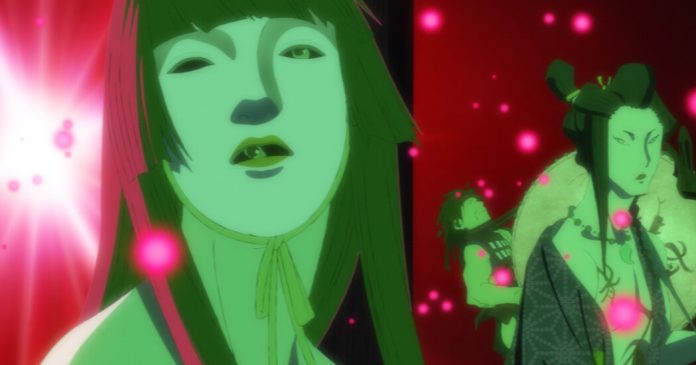Visually luxurious and narratively tangled, the anime “Inu-oh” takes place in 14th-century Japan. The primary story does, no less than. It tells of two younger, audaciously proficient castaways — a blind musician and a cursed dancer — who meet one darkish night. After the standard how-do-you-do, they start performing for one another and shortly slide into enchanted sync. Collectively, they frolic and jam and whirl, and earlier than lengthy they’re levitating, gyrating towards an expanse of shimmery stars as they orbit one another like heavenly our bodies.
It’s becoming that these characters meet on a bridge, on condition that the film spans previous and current, actuality and fantasy. It’s primarily based on a novel, “The Story of the Heike: The Inu-oh Chapters,” by the Japanese author Hideo Furukawa that riffs on “The Story of the Heike,” a foundational medieval epic about clans engaged in civil warfare. A font of innumerable interpretations, the unique story reaches a climax with the battle of Dan-no-Ura, throughout which the Heike clan is defeated, the kid emperor drowned and a sacred imperial sword misplaced. That sword pops up periodically in “Inu-oh” — however good luck understanding why.
What the sword — which at occasions drips blood — has to do with our two whirling strangers isn’t altogether clear. Those that’ve learn Furukawa’s novel, which doesn’t appear to have been translated into English, could don’t have any problem monitoring the film’s labyrinthine turns, its time shifts, storytelling elisions and fantastical thrives. After the primary hour or so and having forgotten a lot of the (complicated!) introductory exposition, I gave up attempting to suit the items collectively. As an alternative, I simply grooved alongside on the often-spectacular animation, savoring its watery hues, vivid character designs and recurrent, galvanizing embrace of near-abstraction.
The director Masaaki Yuasa (“Experience Your Wave”) opens “Inu-oh” with an amazing whoosh of photos that announce his visible ambitions and provide you with little time to determine your bearings. After a brief, vivid dash throughout time, the story settles on Tomona (voiced by Mirai Moriyama), a boy who lives in a fishing village together with his mother and father. At some point, two royal emissaries fee Tomona’s father to dive for a mysterious treasure. It goes disastrously fallacious; the daddy is killed and Tomona blinded. He leaves dwelling however quickly finds a calling, turning into a biwa (lute) participant and ultimately assembly the stranger on the bridge.
That will be Inu-oh (Avu-chan, from the rock band Queen Bee), and his background provides problems. A pariah born with extreme deformities, together with an arm that’s longer than his coltish legs — when he runs, it trails him as perilously as Isadora Duncan’s scarf — Inu-oh hides his face underneath a gourd masks. He additionally speaks with an adenoidal whine and scrambles about with feverish agility that evolves right into a type of superpower after he and Tomona meet. Collectively, they hit the street and refine their skills: Inu-oh turns into a performing sensation and Tomona a proto-rocker, full with squealing biwa and admirers.
Given the eye Yuasa lavishes on these passages, it’s clear that he loves the thought of 14th-century performers rocking out like modern-day enviornment gods. If nothing else, these interludes have a storytelling readability and directness that’s in any other case missing right here. (The script is by Akiko Nogi.) Actually it’s amusing to look at Tomona jam: He performs his biwa behind his head à la Jimi Hendrix (to be clear, the resemblance is strictly gestural), whips round his luxurious mane and bares his chest, lathering up the group. But whereas in time the performances reveal truths in regards to the gamers and their lives, they quickly develop tiresome.
Nonetheless, typically magnificence is sufficient (or virtually). And “Inu-oh” is usually visually arresting, beginning with an early interlude that, with its washes of colour, delicate figures, detrimental house and lateral actions, seems like an animated scroll portray. This sequence, like the remainder of the film, retains a robust hint of the human hand and reveals a deep grasp of (and pleasure in) the medium’s plasticity, all of that are too usually absent in modern industrial animation. Whilst Yuasa’s method modifications from part to part — as he performs with texture, quantity and hue and gently shifts the steadiness between the figurative and the summary — his extraordinary contact stays evident in every line and in each eye-popping swirl.
Inu-oh
Rated PG-13 for gentle peril and loss of life. In Japanese, with subtitles. Operating time: 1 hour 38 minutes. In theaters.


